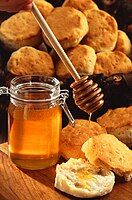
Photo from wikipedia
Honey is a complex foodstuff found in nature which is used without any processing. Honey has been in use in medicine as well as raw food since ancient times. Essentially,… Click to show full abstract
Honey is a complex foodstuff found in nature which is used without any processing. Honey has been in use in medicine as well as raw food since ancient times. Essentially, it is a blend of sugars especially fructose and glucose. The objectives of the study were to determine major sugar composition as well as pesticides contamination in honey samples. Further, Hydroxy-methyl-furfuraldehyde (HMF) level was also determined to ascertain the freshness of honey samples. A total of 14 samples were collected from local market and tested for fructose, glucose, sucrose, HMF and organochlorine pesticides using HPLC and GC–MS techniques respectively. The total sugars in the 14 honey samples were found ranging between 50.26 and 74.74 g/100 g of honey. The chromatographic results showed the presence of the sugars like fructose and glucose in all honey samples. The honey sample SH–11 was found to contain the highest amount of fructose (40.63%). On the other hand, the lowest amount of fructose with 29.08% was observed in SH–7. The HPLC analysis also revealed the presence of sucrose in two samples but under the permissible limit. The average ratio of fructose to glucose in these honey samples was 1.3. None of the sample has ratio below 1.0 indicating lesser chances for honey to crystallize on storage. Out of 14 honey samples, 13 samples were found negative for the presence of any of the 63 pesticides tested. Only sample No. 13, was found to contain 15.95 ppb hexachlorobenzene per kilogram of honey. The HMF was not detected in four samples but in remaining samples it was well below the maximum permissible limit. No pesticide and sugar adulteration was observed in any of the honey samples. The honeys collected from Saudi Arabian markets were found to confirm the standards set by the regional and international standardization organization, the GSO and Codex Alimentarius Commission respectively.
Journal Title: Saudi Journal of Biological Sciences
Year Published: 2020
Link to full text (if available)
Share on Social Media: Sign Up to like & get
recommendations!